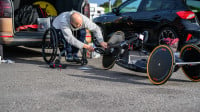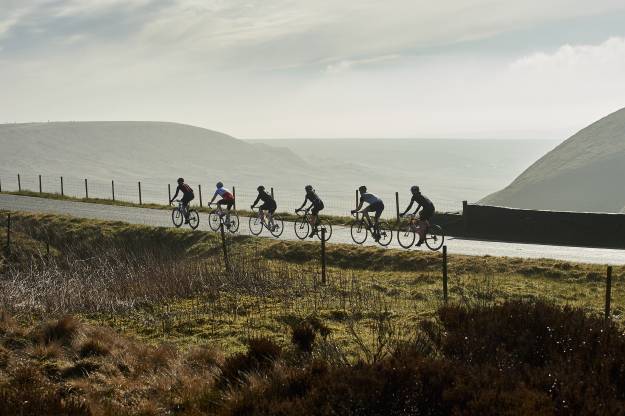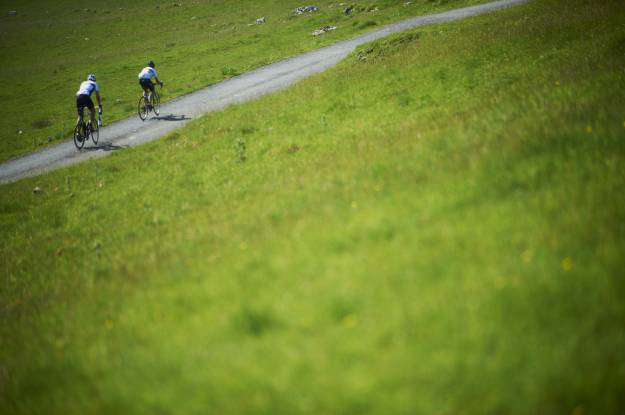If you take part in any sportive, race or even club session, you’ll notice that every cyclist has their own pre-ride routine. This can range from sitting in the car with the heaters blasting until the last possible moment, a few light limbering movements and token stretches before throwing their leg over the top tube, to full on pre time trial efforts on a turbo until they’re streaming with sweat. After the ride, most riders will slump in a heap or join a tea and cake queue. But what is the right thing to do pre- and post-ride and why?
Dr Andy Kirkland, a BASES accredited sports scientist offers his perspective.
Why warm up?
Warming up is essential to prepare your body and mind to perform at its very best, especially when you are facing a hard effort such as a race or an interval session. Not doing so will normally compromise your performance.
Physiological
A warm-up results in a number of physiological responses that are essential for optimal performance. A good analogy is allowing your car engine to warm-up on a cold day. Fuel and oil become more viscous and flows better. Moving parts glide past each other more smoothly and the whole engine performs far more efficiently than if you’d just pressed the accelerator to the floor immediately.
A very important aim of the warm-up is to “switch” your aerobic energy system on prior to you starting your main effort. Doing so means you use energy more efficiently and you are less likely to fatigue prematurely as a result. Your heart rate should be increased progressively, enabling more oxygen to be transported through your blood to and used within the working muscles. With increased body temperature, the range of motion around your joints will also improve and you will get close to your optimal efficiency very quickly.
If you will be doing sprint efforts or preparing for very high-intensity race, neuromuscular activation is also very important. That means that signals will be sent from your brain, through the nervous system to your the muscles to tell them to switch on rapidly. That means doing very short efforts, around 6 seconds long at about 80% maximal effort, to prepare for these demands.
Psychological
Having a planned warm-up routine will help you prepare mentally for your race or training session. Ideally, you should be relatively relaxed and focused on the task in hand rather than worrying about what the competition is doing. You may choose to think about your process goals or race strategies whilst warming up. High levels of anxiety at the start of a race wastes energy and often leads to poor decision making such as starting off too hard. Many riders like to listen to music through headphones during the warm-up as it helps them achieve the appropriate level of arousal and enables them to shut out what others are doing.
How long?
A good rule of thumb is that the shorter and more explosive an event is, the longer a warm-up needs to be. Before an all-out effort such as track sprint, riders may spend more than an hour building up to the race.
For events such as time trials, shorter circuit road races, XC mountain bike and cyclocross events, a warm-up will typically be in the 20-40 minutes range. The British Cycling 20-minute warm-up is perfect before these types of events.
Should stretching be part of my warm up?
The consensus is that static stretching before exercise does not prevent injury or enhance performance. In fact, there is some evidence to suggest that static stretching may be detrimental to the rider. A warm-up should prepare the body for the range and type of movement that the activity demands. A rugby player may use bounding and dynamic twists but, for a cyclist, the most appropriate type of warm-up is on the bike.
Do I need to warm up before a sportive?
Typically the first 10-20 minutes of a sportive will be spent progressively building up to your intended pace or intensity, there is no physiological reason for you to do a specific warm-up. That said, you may still benefit from a systematic warm-up as it will help prepare your mind for the event. For example, it may help relax you, reduce adrenalin levels and help prevent you starting too fast. Additionally, if there’s a testing climb straight from the start, you will benefit from warming-up. Spending 10-15 minutes working through either of these two warm-up protocols would be ideal and will ensure you don’t hit the climb cold.
Of course, with many larger events, because of the sheer number of riders, you won’t have any choice but to start off slow until the crowds thin out.
Why cool down?
A cool down helps return your body to its pre-exercise state and will aid recovery and adaptation processes. It should be viewed as the first step to preparing your body for your next training session, race or event.
Physiological
A progressive cool-down will help remove metabolic waste products from your muscles. If you don’t cool-down, these metabolites will ‘sit’ there and potentially inhibit recovery. A cool-down will also minimise the likelihood of you feeling dizzy, nauseous or fainting post exercise. It will also allow your blood to redistribute around the body, preventing blood pooled in your lower extremities.
Psychological
A cool-down allows you to mentally wind down after a hard workout or event and gives you time to reflect on your performance.
How long?
As with warming-up, higher intensity efforts require longer cool downs to return the body to its pre-exercise state. As a rule, enough time should be taken to progressively bring the heart rate down to near resting levels while still turning your legs over. This will typically take 5-10 minutes and should ideally be factored into the end of every ride.
Should stretching be part of my cool down?
Surprisingly, mainly due to the difficulties in constructing valid studies, there is no clear consensus on whether stretching as part of a cool-down is effective in reducing injury and enhancing recovery or not. What flexibility work does address is a heightened sensitivity in the muscle to ranges of movement beyond those which you experience when sat on your bike or at your desk. This perceived tightness, if left unaddressed, can easily lead to imbalances, poor muscle function and potentially pain or injury.
You may find that your body has become stiff after being in a fixed position on the bike for hours and stretching may help your body return to a normal range of movement. The ideal time to spend 5-10 minutes stretching is as soon as you get off the bike, as your muscle temperature will still be elevated and they will be ‘more open’ to stretching as a result.
However the last thing you’ll want to do after a cold and wet ride is to roll around stretching and you’re unlikely to do a good job. Have your recovery drink, a bath or shower to warm up, put on some warm clothes and then stretch. This mobilisation routine is ideal for post-ride.
Do I need to cool down after a sportive?
We’re not suggesting that you have a turbo set-up at your car to do a full post Tour Stage style cool down but, if you haven’t ridden easy for the last couple of kilometres of the ride or got sucked into a sprint for the line, 5-10 minutes spent spinning easily followed by stretching before jumping in your car would definitely be beneficial and, along with following these recovery guidelines, will allow you to bounce back from the ride faster.










